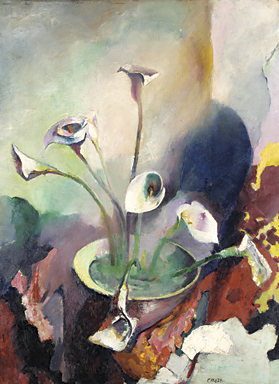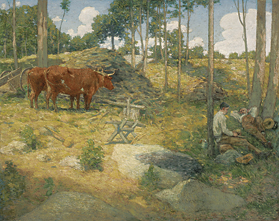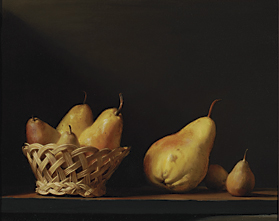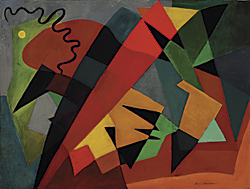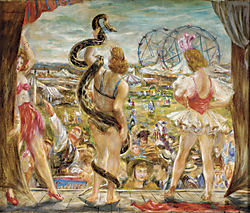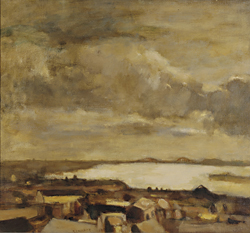 | ||||||
| by Monica Zimmerman | ||||||
| At the beginning of each school term, matriculating students at the Pennsylvania Academy of the Fine Arts gather for an orientation session. Between such nuts and bolts details as locker combinations and studio assignments, Albert Gury, chair of the painting department, introduces them to the academic lineage they are about to become a part of -- it is one of the most important discussions they will have about the education they are about to receive. Gury's introductory talk, which he lightheartedly terms, "The Lineage," helps students see the incredible influence that the Pennsylvania Academy of the Fine Arts has exerted on every generation of painters, sculptors, print-makers, and illustrators since its founding in 1805. Referred to by some students as "Six Degrees of Thomas Eakins," Gury helps students see how European academic traditions, always dominant at the Academy, have passed from teacher to student over countless generations. This spring, The Tradition of Teaching, an exhibition curated by Gury, allows a larger audience the chance to chart these influences through the work of thirty-six of the over two hundred faculty artists who have taught at the Academy since its inception. The artists were selected for their particularly strong influence as mentors and role models on the students they taught. | ||||||
| ||||||
| In the years following Eakins' tenure, William Merritt Chase (1849-1916) and Cecilia Beaux (1855-1942) were instructors of particular note. Best known for their work as first rank portraitists, Chase also excelled at landscapes and still lifes. Both artists studied in Europe during the noisy revolution of French Impressionism and brought the light-infused palette and expressive brushwork into their own art, though neither ever lost sight of their grounding in the fundamentals of realism and figurative drawing. Each cultivated careful public personas, Chase as a genteel but cosmopolitan gentleman and Beaux as the consummate professional. She was the first female faculty member appointed to the staff of the Academy, a bold move in 1895, but one that proved invaluable as Beaux became one of the most sought after portrait painters in the country (Fig. 3), compared regularly to John Singer Sargent.2 At the end of the nineteenth century these two artists, in addition to Thomas Hovenden (1840-1895), Robert Vonnoh (1858-1933), Daniel Garber (1880-1958) (Fig. 4), and others, promoted the Academy's strong traditions while incorporating the latest innovations in technique from Europe. After 1900, the rise of modernism in America jettisoned much popular support for the traditional European-style training obtained at the Academy. Coupled with the institution's inability to keep up with new competition from the myriad art institutions springing up across the country, the early twentieth century has often been referred to as a fallow period for Academy artists.3 However, Academy traditions influenced notable contemporaries of the day who were not necessarily teaching at the Academy, especially Robert Henri (1865-1929), luminary of an influential group of artists known as The Eight. Henri's early studies at the Academy with Thomas Anshutz and Robert Vonnoh imbued his developing philosophies with the importance of realism, a grounding principle in the gritty urban scenes he and his collaborators were eventually known and named for when critics dubbed them the "Ashcan School." In an open letter to the Art Students League in October 1917, Henri himself touted Eakins as a particular influence on his own brand of social realism. "Eakins was a deep student of life, and with a great love he studied humanity frankly. He was not afraid of what his study revealed to him.... Personally, I consider him the greatest portrait painter America has produced." This emphasis on depicting what is real and knowable about contemporary life went on to influence future Academy artists like Francis Speight (1898-1989) (Fig. 5), whose lengthy tenure as Academy faculty spanned 1927-1961, and who was notorious for riding public trolleys around the mill towns of the Schuylkill Valley to capture the true essence of life in suburban Philadelphia. | ||||||
| Several faculty members, including Arthur B. Carles (1882-1952), Henry McCarter (1866-1942), and Hugh Breckenridge (1870-1937) exposed students to components of modernism through their own work as well as several compelling exhibitions in the early 1920s. Carles especially wowed his students with the ability to range across the stylistic gamut from realism to cubism, painting his favorite model as a figural piece and an abstraction in the same year (Fig. 6). Carles had studied at the Academy under Anshutz and Chase, then traveled extensively in France, where he encountered the works of Picasso, Gauguin, Manet, and Cezanne.4 He also met Edward Steichen, and through him, Alfred Steiglitz. The Academy's White Callas (1925-27), a colorful still life by Carles, remains a popular piece for students to copy even today. | ||||||
| An examination of the many illustrious Academy artists, however, reveals not just their aesthetic legacy as painters, sculptors, and printmakers, but also their place in history as versatile, accomplished professionals. J. Alden Weir (1852-1919), a leading American impressionist (Fig. 7) and faculty member in 1912-1913, was known as a skilled etcher and engraver, as well as a founding member of organizations like The Ten American Painters and the Society of American Artists. As passionate about anatomical accuracy as Eakins, George Bridgman (1865-1943), who taught at the Academy in 1921 and is represented simply by a book in the exhibition, is best known today for his seven tomes on anatomy. A 1942 Time magazine article revealed that he kept a pile of wrist and finger bones in his pocket and accepted a dismembered human leg from a friendly taxi driver.5 His resulting books are so exquisitely rendered and so exhaustive that they continue to be vital sources for art students of all skill levels. | ||||||
The examination of Arthur De Costa's (1921-2004) contributions (Fig. 8), a more recent faculty member who taught from 1966 until 1988, includes his development of the first alkyd synthetic oil medium, now sold commercially. De Costa's innovation allowed artists to move paint more freely and accurately, the better to replicate Old Master styles. Other faculty members were equally innovative in multiple fields, including Violet Oakley (1874-1961), known as a muralist, illustrator, lecturer, and pacifist, and the trio of Daniel Garber (1880-1958), Morris Blackburn (1902-1979) (Fig. 9), and Roswell Weidner (1911-1999) (Fig. l0), who all excelled not only at painting, but also as printmakers. Blackburn, a student of McCarter, Garber, and Carles, was known particularly for his ingenuous ability to use printmaking techniques to experiment with modernist principals like cubism. | ||||||
The Tradition of Teaching pays special attention to the most under-examined period in the Academy's history, the 1960s and 1970s, a time of tremendous growth both at the Academy and in the narrative of American art history. As mentors and teachers during this time, Jimmy Lueders (1927-1995), Hobson Pittman (1899/90-1972), Morris Blackburn, Arthur de Costa, Seymour Remenick (1923-1999), Robert Beverly Hale (b. 1901), and Ben Kamihira (b. 1925) all cultivated and challenged the rising talents of the next generation of American artists. Robert Beverly Hale's penchant for the dramatic made him beloved as a lecturer. Seymour Remenick (Fig. 11) was unparalleled in his forthrightness and honesty, able to critique the mistakes of his students without being negative. Gury remembers him as having "a style both evocative and seductive, a painting approach that you fell in love with." Ben Kamihira had the masterful ability to help young artists chart an identity and discover what the true nature of being a painter could mean for them. | ||||||
Arthur De Costa had a particularly strong influence on his students, partly because of his generous and passionate dedication to teaching. De Costa believed vehemently in the superiority of the Old Masters, demonstrating traditional oil techniques in the classroom and inspiring students to legitimize the pursuit of beauty through art at a time when modernism prevailed.6 His choice of attire in the classroom -- coat, tie, and white lab jacket -- have been incorporated into the teaching philosophies of several of his students who today teach at the Academy. A cluster of works by De Costa in the exhibition, showcasing his facility with both the figure and the still life, act also as an homage by the curator, whose obvious respect for his former teacher conveys the essence of the lineal traditions that exist at the Academy. While the influence of the Academy's gifted faculty on twenty-first century art has yet to be discovered, innovation and expansion of the facilities and programs ensures future generations of American artists will have the opportunity to be part of "the lineage." Students receive an education grounded in the fundamentals and access to a critically lauded collection of historically significant artwork and casts. The acclaimed Morris Gallery program provides exposure to cutting-edge artwork, while the Academy's museum exhibition program regularly features canonical artists and themes in American art. Recent renovations to the Samuel M. V. Hamilton Building, resulting in additional gallery spaces, artist studios, and administrative offices, have created a buzz of excitement in the hallowed halls of one of America's oldest and most prestigious art institutions, as has the ,newly approved BFA degree. At the beginning of its third century, the Academy continues to foster a passionate and dedicated community of students and faculty members, capable of harnessing the best academic traditions to new frontiers of American art. | ||||||
| | ||||||
| The Tradition of Teaching is on view in the School of the Fine Arts Gallery: Gift of the Women's Board, at the Pennsylvania Academy of the Fine Arts, Philadelphia, until April 13, 2008. For more information call 215.972.7600 or visit www.pafa.org. | ||||||
| | ||||||
| Monica Zimmerman is the program coordinator for the Pennsylvania Academy of the Fine Arts. All images courtesy of the Pennsylvania Academy of the Fine Arts. | ||||||
| | ||||||
| 1. Ronald J. Onorato, "Exciting the Efforts of the Artists: Art Instruction at the Pennsylvania Academy of the Fine Arts," in Pennsylvania Academy of the Fine Arts: Two Hundred Years of Excellence (2005). 2. Sylvia Yount, Cecilia Beaux: American Figure Painter (Los Angeles and Berkeley: University of California Press, 2007). 3. Stephen May, "An Enduring Legacy: The Pennsylvania Academy of the Fine Arts, 1805-2005," in Pennsylvania Academy of the Fine Arts: Two Hundred Years of Excellence (2005). 4. Frank Goodyear, "A History of the Pennsylvania Academy of the Fine Arts, 1805-1976," in In this Academy, The Pennsylvania Academy of the Fine Arts 1805-1976 (1976), 12-49. 5. "Bone and Muscle Man," Time (14 September 1942). 6. Patrick Connors, "The Legacy of the Pennsylvania Academy of the Fine Arts," in American Arts Quarterly 21.1 (Winter 2004). See also Doreen Bolger, "The Education of the American Artist," in In this Academy, 51-74; Cheryl Leibold, "To Assist and Excite: Art Education at the Pennsylvania Academy of the Fine Arts," in The Unbroken Line: A Suite of Exhibitions Celebrating the Centennial of the Fellowship of the PAFA (1997), 13-17. |
Showing posts with label Art Eduaction. Show all posts
Showing posts with label Art Eduaction. Show all posts
Tuesday, November 9, 2010
The Tradition of Teaching
Subscribe to:
Comments (Atom)






